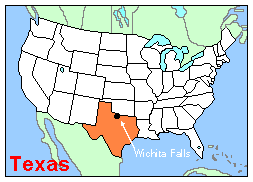Australian Plants in Texas Climate - USA
more detailed mapGeneral Climate Comments
Plantings and observations - February 2004
Eucalypts
Ferns
Other
Plantings and observations - September 2004
General Climate Comments:
I am located in Wichita Falls, Texas, USA 76308. My property is situated at 33.54N latitude 98.29W longitude. The area experiences a continental climate and is situated at the intersection of several geo-climatic regions. The Great Plains stretch north to into Canada, the Gulf of Mexico is approximates 300 mile southeast, the Rocky Mountains culminate in the neighbouring state of New Mexico, and the westerns desert stretch to the California costal ranges. The region is situated nearly on the continental "dry line", the juncture of wetter, moister eastern climates and dry western weather patterns. This leaves the area prone to, among other phenomena, spring tornados. There is no distinct wet or dry season and the temperature range can be extreme.
Here, we are generally classified as a USDA zone 7B due in most part to one (or in a rare year 2) days each winter when temperatures dip just below 10°F (-12°C) (compare with Australian hardiness zones). Generally, though, our winters are dry and mild with typical highs near 50°F (10°C) with lows in the upper 20’s (°F) or just above the freezing point, more in keeping with a zone 8 classification. There are almost no days when the winter high temps don’t get above freezing and the ground does not freeze. We are located within Sunset Climate Zone # 33 although there are certain similarities with #10 as well.
The winter of 2003-2004 was fairly typical. Our first hard frost was in late November and most of Dec. was quite warm – in the 50’s and 60’s (°F), for most daytime highs. During the first days of January, however there was a severe cold snap where the temperature dropped suddenly to 7°F (-14°C) one night, rose to near the freezing point the following day, dropped off to 18°F (-7°C) that night and then warmed up considerably, hitting 80°F (27°C) later the same week.
Summers, by contrast are drought-prone and hot, with temps regularly exceeding 100°F (38°C) for several month on end. In Australian terms, our winters (with the exception of the one to two day extremes) are on par with Canberra’s averages whereas the summers are closer to Alice Springs (www.weather.com source)
Matt Tirpak
Sept 2004
Plantings and observations – February 2004
Eucalyptus
1) Eucalyptus neglecta
Individual Plant Characteristics:planted as tube stock, autumn 2003
Site/Location:open area in northwest quadrant of fenced property. Full sun and element exposure – planted as lawn specimen. From trans-Pacific nursery McMinnville, Oregon, USA.
Winter protection: none, but mulch
Condition on 19 Feb, 2004:red winter coloration 6 in tall no noticeable damage
2) Eucalyptus neglecta
Individual Plant Characteristics:nursery gallon sized plant appx 3 ft. tall planted autumn 2003. from forest farm nursery, Williams Oregon,usa
Site/Location:planted as lawn specimen fully exposed to sun and elements
Winter protection:none, but mulched base
Condition on 19 Feb, 2004:winter red coloration. Young leaves in production.
3) Eucalyptus neglecta
Individual Plant Characteristics: planted as nursery gallon stock, 3-ft tall in autumn 2003. from forest farm nursery, Williams Oregon,usa
Site/Location:planted in mulched bed along w-e fence line with s exposure.
Winter protection: none
Condition on 19 Feb, 2004:3 ft tall, winter red coloration, active leaf prodution.
4) Eucalyptus nicholii
Individual Plant Characteristics:5- gal plant appx 4-5 ft tall. From Lowes Nursery, Pensacola, Florida
Site/Location:in nursery pot set in bamboo grove in southeast quadrat of property near large ash trees.
Winter protection:none
Condition on 19 Feb, 2004:total leaf damage. Trunk had shown signs of life earlier in month, but drying out now, despite irrigation and rainfall
5) Eucalyptus cinerea
Individual Plant Characteristics: 5 gallon 4 foot tall plant. From Lowes Nursery, Pensacola, Florida
Site/Location:Planted at corner of wood deck, 3 metres from the trunk of a large dormant pecan tree. Stone mulch at base. Eastern, southern, and western exposure. Protected from north by deck and house.
Winter protection:none
Condition on 19 Feb, 2004:fresh, undamaged blue-green leaves. Looks vigourous. No signs of damage
6) Eucalyptus cinerea
Individual Plant Characteristics:tube stock planted in late summer 2003. appx. 12 inch tall
Site/Location:planted in mulched bed along w-e fence line with s exposure.
Winter protection:none
Condition on 19 Feb, 2004:winter red coloration, some burnt spots on some leaves, but stems and bud tips look healthy and supple.
7) Eucalyptus cinerea
Individual Plant Characteristics: tubestock planted late summer 2003
Site/Location: planted in mulched bed against west facing brick wall – appx 2 metres from wall
Winter protection:none
Condition on 19 Feb, 2004:red winter coloration. Supple leaves – no signs of damage
8) Eucalyptus polyanthemos
Individual Plant Characteristics:9-ft tree planted autumn 2003 from Mikes Nursery South Lake, Texas USA
Site/Location:planted with southern, eastern, and northern exposure in mulched bed appx 3 ft from edge of concrete drive way. Stone and shredded bark mulch.
Winter protection:lower trunk wrapped in cardboard
Condition on 19 Feb, 2004:100% leaf death. Trunk is alive (green cambium) and small branches are supple and show green colour on surface. Expect to recover
9) Eucalyptus polyanthemos
Individual Plant Characteristics:7-foot tree from Mikes Nursery, South Lake Texas, USA
Site/Location:planted on treeline along north side of house (2 metres from house) in raised mulched bed along gravel path.
Winter protection:clear plastic frost tent. Lower trunk wrapped in cardboard
Condition on 19 Feb, 2004:100% leaf death. Some branches show green when scratched, others shriveled and brittle. Trunk has green cambium.
10) Eucalyptus polyanthemos
Individual Plant Characteristics: tube stock planted late summer, 2003. From Santa Barbara, California, USA
Site/Location:planted on treeline along north side of house (2 metres from house) in raised mulched bed along gravel path.
Winter protection:mulched high
Condition on 19 Feb, 2004:exposed areas burnt; buried areas green, supple, and alive
11) Eucalyptus polyanthemos
Individual Plant Characteristics: 7-foot tree from Mikes Nursery, South Lake Texas, USA
Site/Location: planted in mulched bed along w-e fence line with s exposure
Winter protection:clear plastic, frost tent. Dark coloured tarp back drop to cut north wind.
Condition on 19 Feb, 2004:100% leaf death. Trunk shows green cambium
12) Eucalyptus polyanthemos
Individual Plant Characteristics:tubestock planted late summer 2003
Site/Location:planted in mulched bed along w-e fence line with s exposure
Winter protection:plastic sleeve, high mulching.
Condition on 19 Feb, 2004:exposed area burnt. Buried area green and supple
13) Eucalyptus polyanthemos
Individual Plant Characteristics:tubestock planted late summer 2003
Site/Location:planted as lawn specimen.
Winter protection:plastic sleeve, high mulching.
Condition on 19 Feb, 2004:exposed area burnt. Buried area green and supple with full green leaves present
14) Eucalyptus polyanthemos
Individual Plant Characteristics: 9-foot tree from Mikes Nursery, South Lake Texas, USA
Site/Location: planted in mulched bed along w-e fence line with s exposure
Winter protection:clear plastic, frost tent. Dark coloured tarp back drop to cut north wind.
Condition on 19 Feb, 2004:100% leaf death. Trunk shows some green cambium. Many minor branches appear lifeless
FERNS
1) Cyathea australis
Individual Plant Characteristics: untrunked plant from Mikes Nursery, South Lake, Texas
Site/Location: planted in mulched bed under old, established pecan tree
Winter protection:surrounded by wire cage packed with costal straw
Condition on 19 Feb, 2004:100% leaf death. No new growth apparent today
2) Cyathea Australis
Individual Plant Characteristics: 6-foot tree from Mikes Nursery, South Lake Texas, USA
Site/Location: planted in mulched bed under old established pecan tree just south of gazebo structure.
Winter protection:trunk wrapped in burlap, crown wrapped in palm thatch. Clear plastic tent erected around whole. Deep mulch of costal straw.
Condition on 19 Feb, 2004:100% leaf death. No new growth apparent today
3) Nephrolepsis obliterata
Individual Plant Characteristics: large hanging baskets from Home Depot nursery, Wichita Falls, Texas.
Site/Location: planted in mulched bed at base of wooden deck. Western exposure
Winter protection:surrounded by wire cage packed with costal straw
Condition on 19 Feb, 2004:old fronds died back but actively growing new ones emerging from soil.
4) Dicksonia antactica
Individual Plant Characteristics: 4-foot tree from Mikes Nursery, South Lake Texas, USA
Site/Location: planted in sheltered area under carport and on east side of brick wall. Red lava rock mulch.
Winter protection:trunk wrapped in thick quilt
Condition on 19 Feb, 2004:100% foliar death. Leaf bases green. No new growth today
OTHER AUSSIES
1) Callistemon citrinus
Individual Plant Characteristics: 2 – 4 foot bushes. Had survived previous winters containerized on a 2nd floor balcony.
Site/Location: planted between wooden deck and old established pecan tree in mulched bed near Eucalyptus cineria. Also along west facing brick walls.
Winter protection: none
Condition on 19 Feb, 2004: Total foliar die-back. Terminal branches show no signs of life (ie green cambium)
2) Olearia argophylla
Individual Plant Characteristics: tube stock planted autumn 2003
Site/Location: planted between wooden deck and old established pecan tree in mulched bed near Eucalyptus cineria in stone mulch.
Winter protection: none
Condition on 19 Feb, 2004: killed to ground, no growth yet
3) Olearia solandrii
Individual Plant Characteristics: tubestock planted autumn 2003
Site/Location: planted along west facing brick house wall
Winter protection: none
Condition on 19 Feb, 2004: no damage. Golden-green leaves
Plantings and observations – September 2004
The past summer proved to be uncharacteristically cooler and wetter than typical for the U.S. southern plains. Daily high temperatures ranged in the 90's (Farenheit) for the most part with only 4 days above 100°F (38°C). The summer received ample summer rains which is unusual for the region as well. As a result several of the Australian Species planted in Autumn 2003, Winter 2004 and Spring 2004 performed quite well.
Callistemon citrinus. - Several of the plants burned back by the January cold-snap rebounded impressively to 50% - 125% foliar recovery.
Callistemon viminalis - Has spent the summer becoming established.
Cyathea australis and Dicksonia antactica did not recover from cold snap damage, but replacements have been installed to test a new winter protection scheme this year.
Nephrolepsis obliterata - 50% recovery of original size after being killed to the ground over winter.
Brachycome - full recovery with bloom
Olearia solandrii - no winter damage and has doubled its spring size.
Melaleuca spathulata - installed spring 2004 has significantly "filled out"
Eucalyptus neglecta - 6 inches new growth on all specimems - no winter damage
Eucalyptus polyanthemos -
* defoliated individual fully recovered and has shown recent growth spurt
- winter defoliated to branches - deciduous habit
* 3 individuals killed back to ground
1 shows 50% vigourous recovery
1 shows 20% vigourous recovery
1 shows 10% recovery
* 2 juveniles have shown minimal growth thus far, but came through winter
with virtually no damage under a thick cypress mulch
Eucalyptus cinerarea
* 2 individuals have doubled winter size
* 1 individual has shown steady growth since winter
* 3 spring planted individuals have doubled size
Eucalyputs nicolii
* spring planted indiviudal has grown 30% taller
Eucalyptus parvula
* no winter damage but minimal growth in shaded position
Eucalyptus bridgesiana
* summer planted - 100% increase in size
Eucalyptus ????
finer textured leaves than nicholii - similar to spathulata, radiata, odorata,
or leptophylla - march planted - 100% increase
Eucalyptus robusta
* 4 spring planted individuals 300% growth
Eucalyptus camphora
* recent foliar dessication in the autumn dry, but showing new growth with
irrigation
Eucalyptus citrodora
* 2 specimens planted in summer have recently shown vigourous new growth.
Eucalyptus deglupta
* containerized specimem 100% growth increase
Hardenbergia comptoniana
* 3 winter planted individuals have increased 100%
Eucalypt observations
After an autumn, winter, spring, and summer in the ground, I would recommend the following Eucalypts for the local growing area
E. neglecta
In winter the plants stood completely unprotected and took on their attractive
burgundy winter colouration. As the spring days warmed, they lightened to their
mint green and shot out new growth. They showed no winter damage at all in my
trials. They have come through two summers unscathed and showed no sign of heat
or water stress in either 2003 or 2004. They maintained good growth through
the autumn from September until December when evening frosts became more regular
and curtailed growth for the season. I have tried this species much further
to the north in the wet winters of the Great Lakes region where the euc was
best planted in a sheltered position against a south facing wall and treated
as a die-back perrenial. In the winter of 2002, I conducted other trials with E. neglecta on a different property and they likewise come through admirably
(2002 was a winter with several nights in the teens °F) as well as survived
transplantation and sprang back after "wet-feet" defoliation and drought stress
defoliation while containerized for a few months. A tough, versitile, and attractive
species that bears further trials in a widening range of conditions and further
U.S.. distribution and planting.
E. cinerea
The 7 specimens planted in a variety of partial to full, morning or afternoon
sun situations are my choice for north Texas Eucalypt runner-up. Trees with
morning exposure generally fared better than those who had to wait longer through
the day to receive their sun. The morning sun trees whether in partial or full
sun maintained full foliage and the typical blue colouration throughout the
winter. Afternoon sun trees adopted a redish colouring and universally exhibited
50% defoliation. Spring growth resumed early for both groups with the ful afternoon
sun individuals showing the fastest initial growth (not surprising considering
they had the most "catching up to do). No branch death or damage was experienced
by any plant. By September all individuals had at minimum doubled their autumn
2003 size and are in an autumn growth flush. Given favourable situation (morning
sun) , this species shows potential for further trials and application to the
landscapes of north central Texas and similar climates.
E. polyanthemos
The six specimems showed remarkable different performance through the year since
their planting in autumn 2003. Four tree-sized (2-3 metres) and two juvenile
(less than 1 foot tall) individuals were planted in a variety of situations.
The best performers were the two juveniles which were mulched deeply and protected
by plastic frost tents. One was planted in a a sunny shrub border and the other
as a lawn specimen which received mostly afternoon sun. only the terminal leaves
were burnt and the young plants recovered quickly in the spring. One of the
"tree sized" individuals was planted in a triangular bed between a paved driveway
and a sidewalk. The bed had a south-southeast aspect and featured several large
rocks and a stone mulch. The tree's trunk was shielded to the north by a meter
high sheet of corrugated cardboard, but not covered.. This tree was 98% defoliated
by the one-night cold snap that plunged temps to 7°F (-14°C) and was
followed by a day at 85°F (30°C) later that week. Previous to that,
the tree had taken on the typical red winter colouring of many euc species.
Several terminal leaves survived cold damage and were protected with blankets
any night temperatures were forecast below 20°F (-7°C). The tree regained
full foliage through the spring and summer months, has developed several vigourous
new branches, and the trunk has doubled in circumference. The three remaining
"tree sized" individuals were planted in a shrub border on an east-west axis
along the south side of a wooden fence. They were loosly shielded through the
winter with plastic sheeting. All three of these individuals suffered significant
die-back all lignous and foliar parts killed to the ground. All three were quick
to begin new growth in the late winter and their recovery seems to be a function
of the sunniness of their position and their proximity to irrigation. Several
of the 6 E. polyanthemos individuals exhibited drought str ess through
the summer and into the autumn. They were the plants to show signs of wilting
in a bed of North American Chilopsis and Yucca, Asian Photinia, and Australian E. cinerea. This species clearly benefitted from morning sun exposure
and a full sun situation, but required supplemental water even in the exceptionally
wet summer of 2004. E. polyanthemos would be an interesting possibility
(a deciduous eucalypt) for more committed gardeners, but by no means a trouble-free
plant for north central Texas. My guess here would be that fire adaptations
can serve Eucalypts grown in regions that experience periodic severe temperature
drops.
Callistemon observations.
The Callistemon citrinus that I planted out in the summer of 2003 performed well through the drough-ravaged summer (even when the irrigation system was not available for one month) and bloomed through the fall. The 1-night 7 degree f cold snap however created much damage. All plants were defoliated with perhaps 2 or 3 green viable leaves between 9 plants. Prior to being planted out along a deck foundation and the partial shade of a large pecan tree, the plants were containerized on a second floor covered balcony with south and western exposure through the winters of 2001 and 2002 where they would suffer some leaf burn. The winter of 2003-2004, from which they were offered no protection, essentially took them all to the ground. As spring warmed, approximated 50% of the plants slowly regained 50% of their autumn 2003 foliage and branches. Now in September 2004, they are growing vigorously, preparing to flower and have surpassed their size of a year ago. The plants would probably have fared better in a sunnier location or if a heat-retaining stone mulch had been used in lieu of shredded eucalyptus. Winter damage should be expected from this species in this area. Likewise, shade/partial shade plants should not be counted on to rebound quickly in the spring.
![An Australian Government Initiative [logo]](/images/austgovt_brown_90px.gif)








